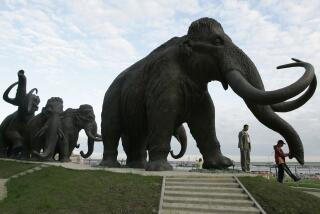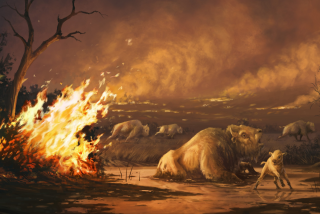Scientists zero in on reason for mammoths’ demise
About 15,000 years ago, North America was home to an astonishing number of large plant-eating mammals -- giant sloths, mastodons, mammoths. A thousand years later, they were all gone, wiped from the face of the Earth with sudden finality.
Scientists have floated a variety of possible explanations for this mass die-off, from climate change to a cataclysmic asteroid impact. But now a team of American researchers may be closing in on the answer, hidden in the thousands-year-old muck of an Indiana lake.
To track the population of large herbivores, scientists analyzed the pollen, charcoal and fungus in ancient sediments beneath Appleman Lake, a 35-foot-deep body of water left behind when the last ice age ended 20,000 years ago. The research focused on the amounts of the fungus Sporormiella present in the sediments, according to Jacquelyn Gill, a graduate student at the University of Wisconsin, Madison and a co-author of the paper appearing in today’s issue of the journal Science.
Because the fungus is commonly found in the dung of large plant-eaters, its prevalence in the fossil record should be a direct measure of population density, Gill said. The research team found that the decline of the large mammals started about 14,800 years ago -- and was virtually complete a thousand years later.
“About 13.8 thousand years ago, the number of [fungus] spores drops dramatically,” Gill said.
In the end, a total of 34 types of large animal disappeared.
According to Gill and the other researchers, from the University of Wyoming and Fordham University in New York, these dates eliminate several possible reasons for the mass extinction that were put forward previously.
The first is habitat loss due to a changing climate. Around this time, tree species such as black ash, elm and ironwood began spreading across the landscape of North America. According to Gill, the die-off of the big mammals predated this change. In fact, the loss of the big herbivores may have helped precipitate it. Without the large plant-eaters around to keep them in check, the tree species were free to colonize the countryside.
Another theory suggested that a comet or meteor impact that occurred about 12,900 years ago could have wiped out the big mammals in the same way that a similar but larger impact is believed to have killed off the dinosaurs. The new timeline shows the extinction event was already over when that impact took place, Gill said.
A third theory held that the animals were wiped out by a so-called “blitzkrieg” of hunting by Clovis culture humans. The Clovis culture is distinguished by the fluted spear points used by hunters to bring down large animals. But according to Gill, the die-off was already underway before the Clovis hunters arrived. “This was already happening before humans adopted the Clovis tool kit,” Gill said.
The new evidence doesn’t mean humans didn’t play a central role in the decline of megafauna, said Christopher Johnson, a professor of biology at James Cook University in Australia who wrote an accompanying perspective article in Science.
Even if the Clovis hunters, with their advanced technology, did not start the decline, “they were certainly part of the story, and probably account for the final demise,” Johnson said.
“My view of all the evidence . . . is that human hunting was the sole cause of the megafaunal extinction, and that other factors such as climate change had nothing to do with it.”
Gill isn’t ready to go that far.
“What we’ve been able to do is start to eliminate some hypotheses” for the die-off, she said.
“We’re not ruling out humans so far,” she said, but she doesn’t feel she has enough evidence to point a finger at human hunters. She said that her research is continuing at the lake and that more discoveries may be coming.
More to Read
Sign up for Essential California
The most important California stories and recommendations in your inbox every morning.
You may occasionally receive promotional content from the Los Angeles Times.










